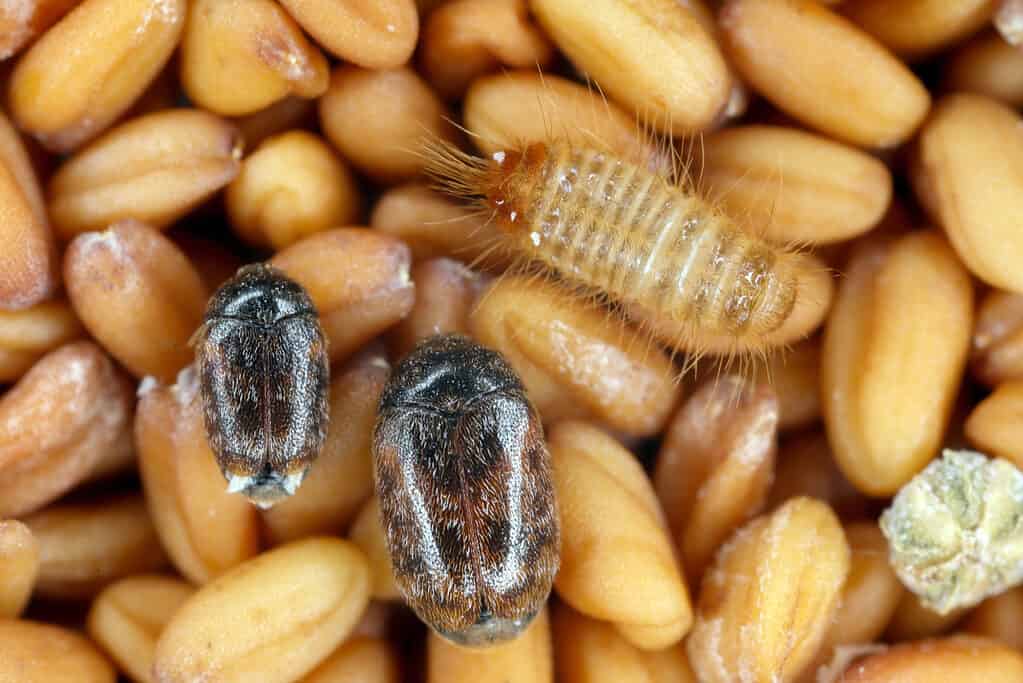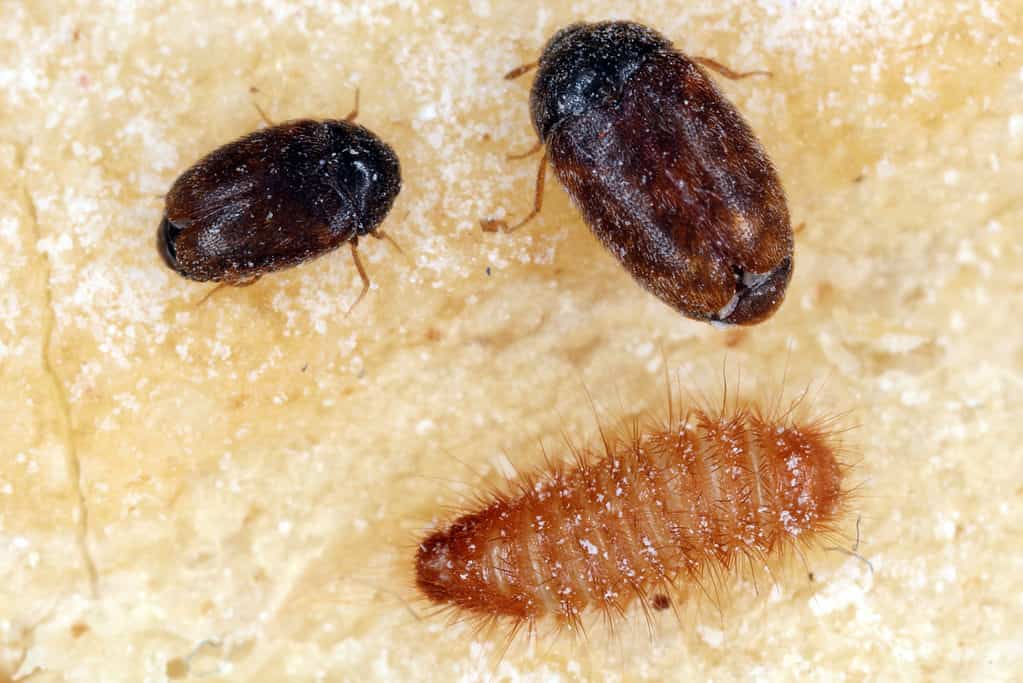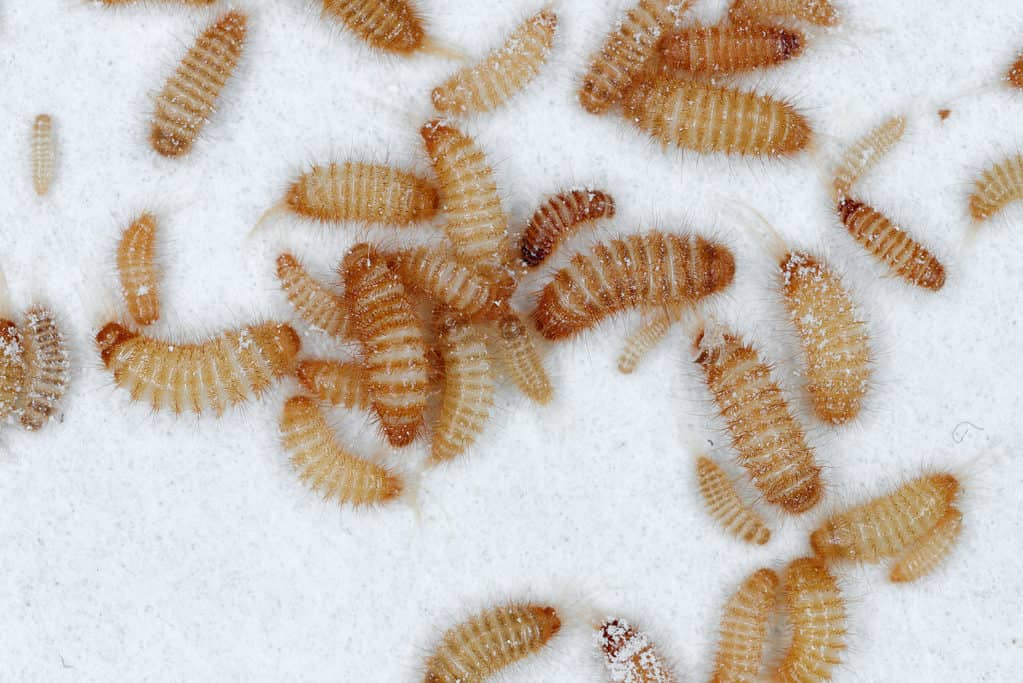Khapra Beetle
Trogoderma granarium
Khapra beetles are among the most invasive insect species in the world.
Advertisement
Khapra Beetle Scientific Classification
- Kingdom
- Animalia
- Phylum
- Arthropoda
- Class
- Insecta
- Order
- Coleoptera
- Family
- Dermestidae
- Genus
- Trogoderma
- Scientific Name
- Trogoderma granarium
Read our Complete Guide to Classification of Animals.
Khapra Beetle Conservation Status
Khapra Beetle Facts
- Name Of Young
- Larvae
- Group Behavior
- Infestation
- Fun Fact
- Khapra beetles are among the most invasive insect species in the world.
- Most Distinctive Feature
- Khapra beetles have distinctive yellowish-brown antennae
- Distinctive Feature
- Their body is covered in brown or red-colored hair.
- Other Name(s)
- Cabinet beetle
- Habitat
- Sacks, grain processing plants, pantries, silos, and other locations where dry foods are stored.
- Predators
- Insectivorous insects, nematodes and some parasitoids
- Diet
- Herbivore
- Favorite Food
- Dry food products
- Type
- Beetle
- Common Name
- Cabinet beetle
- Special Features
- Khapra beetles are tiny, making them difficult to detect
- Origin
- Asia
View all of the Khapra Beetle images!
Khapra beetles are persistent pests native to South Asia but are now found in various locations worldwide. They eat seeds, grains, and cereal products and can survive long periods without food. On introduction to a new environment, the population multiplies rapidly and becomes a problem because of its resistance to pesticides. They reduce the economic quality of food and cause health problems too. The species is ranked among the top 100 most invasive animals on earth.
Khapra Beetle Species, Types, and Scientific Name
The Khapra beetle’s scientific name is Trogoderma granarium. The species is commonly referred to as the cabinet beetle. It belongs to the order Coleoptera, the largest and most diverse order of insects. The Coleoptera order includes up to 40% of insects.
Within the Coleoptera order, the khapra beetle belongs to the family Dermestidae (a family of scavenger beetles that feed on dry plant and animal matter). There are more than 1,100 species of beetles in this family. Beetles in this family are also known by other common names, such as warehouse beetles, colored cabinet beetles, leather beetles, ornate beetles, or carpet beetles.

The khapra beetle is ranked among the top 100 most invasive animals on earth.
©iStock.com/Tomasz Klejdysz
Appearance — How To Identify Khapra Beetle
The khapra beetle is a tiny beetle usually found in association with stored produce. The small size means the beetle often goes unnoticed until an infestation is underway. A mature male khapra beetle is usually 0.05 to 0.1 inches long and 0.03 to 0.04 inches wide. The females are slightly bigger. They are about 0.08 to 0.13 inches long and are as broad as 0.06 to 0.07 inches.
The beetle is oval-shaped and covered in brown or red-colored hair. The females are generally lighter in color than the males. The color of khapra beetle eggs ranges from milky white to pale yellow. They are more cylindrical, with spines on one of their ends. A typical egg has a length of 0.028 inches and a width of 0.01 inches.
Like most insects, the body has a head, abdomen, and thorax. It also has three pairs of well-jointed yellow legs. Khapra beetles have distinctive yellowish-brown antennae as well. Their antennal club is divided into three to five segments. There is a link between the beetle’s physiology and what it feeds on. It thrives best when it feeds on rye. On the contrary, they have an overall small size and low fertility in rice and walnut.

Khapra beetles are oval-shaped and covered in brown or red-colored hair with females being lighter in color and larger in size than males.
©iStock.com/Tomasz Klejdysz
Habitat — Where To Find Khapra Beetle
Trogoderma granarium thrives best under hot and dry conditions. Like other insects in their family, khapra beetles hang around in locations where dry food products are stored in large quantities. These include sacks, grain processing plants, pantries, silos, and many others.
There is limited knowledge about the beetle’s life outside the human environment because it is synanthropic (a species of animal mostly found within the human environment). Unfortunately, humans that come in contact with infected food suffer from gastrointestinal illnesses and skin problems.
The origin of these destructive insects can be traced to India. But they have also been discovered in countries across the Mediterranean, Africa, and Asia. Records of the destructive pest have been found in the United States too. However, the country has been able to contain the pest situation successfully. There have been reports of the beetle in Australia as well. They were observed recently (2020) in Canberra, Australia.
The Federal Agriculture Department took appropriate actions immediately and contained the species effectively. They also made an updated effort to enlighten the public on ways to avoid future infestations.
It is also common to find the khapra beetle in sea-faring containers used to transport food products. In Sri Lanka, the first discovery of the species was in a shipping consignment in 2017. The level of infestation depends on the type of food to be transported. For instance, beetle flourishes greatly in whole barley flour and cracked wheat kernels.
Evolution and History
Scientists believe that beetles came into existence in the Carboniferous Period 300 million years ago. The conclusion was based on evidence from the fossil record. The earliest beetle remains were estimated to be about 295 million years old. This means they were around before the dinosaurs came on the scene.
Beetles diversified extensively, with modern species appearing during the late Cretaceous Period (about 66 million years ago). Over the past several million years, beetles have demonstrated strong resistance to extinction as they remain largely unaffected by the major extinction events that have occurred over the years.
Like many other beetles, the khapra beetle has evolved hardened forewings (elytra). Although they cannot fly, the elytra protect their wings. Their small sizes also allow them to crawl into crevices easily and remain undetected for long periods. The species are also resistant to malathion and phosphine, major components of insecticides. The theory behind this is that their genetic constituents have been modified to tolerate these chemicals. Few individuals survive initial exposure to pesticides or insecticides and can pass this resistance over to subsequent generations. As a result, the new offspring show even greater resistance to the chemicals.
Due to its invasive nature, the khapra beetle spread from its origin in Asia to other locations. In 1953, the destructive beetle was discovered for the first time in California, USA. The beetle had already spread to Arizona, New Mexico, Texas, and other parts of the country between 1968 and 1983. Efforts were made to eradicate them to control the situation. There are still reports of pest discovery at the entry of various ports.
Diet — What Do Khapra Beetles Eat?
The major food of Trogoderma granarium consists of grains and other related dry stored food. These include wheat, rice, barley, rye, and maize. They also eat noodles, flour, spices, and other stored food products.
Khapra beetle larvae have a voracious appetite as well. They cause devastating economic damage to crops by feeding on their grains and seeds. Most times, the grains are reduced to powder, and only the husks are left behind.

Khapra beetle larvae have a voracious appetite feeding on grains and seeds, reducing them to powder.
©iStock.com/Tomasz Klejdysz
What Eats Khapra Beetles?
Khapra beetles have many natural enemies. Larger insects, such as pirate bugs, nematodes, and parasitoids, feed on these beetles. The species is also affected by bacteria such as Bacillus thuringiensis
Prevention — How To Get Rid of Khapra Beetle
Not only does this beetle cause economic losses to the agricultural sector, but it also poses health risks. The larva of the khapra beetle sheds its skin about four to 15 times before they reach the maturity stage. They lose their hair in the process as well. The discarded body parts contaminate stored food and make them unhealthy. Their waste products, such as urine, make food unsafe to consume. These are enough reasons to guard against an infestation of this insect at all costs, even though they do not have a direct negative impact on the environment.
Although the khapra beetle is resistant to pesticides, the continuous regular application works. The best way to get rid of them is to use methyl bromide as a fumigant. People in India make use of neem powder to repel the beetles. It does not kill them, though. Insects generally avoid neem because of its odor.
Extreme temperatures are unsuitable for the beetle as well. But, this method only works for the adult beetle. The larva can still survive under these conditions. Datura metel, a species of perennial shrubs, has also been effective in getting rid of them. Extract from the leaves of the plant is toxic for both the adult khapra and its young ones.

Extract from leaves of the Datura metel plant can be used to get rid of khapra beetles since it is toxic for both the adult khapra and its young.
©iStock.com/Deny Novan
There is an increasingly growing global awareness of how much of a threat the khapra beetle can be. So, active efforts are taken to prevent the transportation of infested food to a new region. The shipping containers are also fumigated after every use to avoid dangerous pests.
Related Animals
View all 77 animals that start with KKhapra Beetle FAQs (Frequently Asked Questions)
Are khapra beetles dangerous?
Khapra beetles do not cause direct harm to humans. But their waste products and the body parts they shed in their larval stage can cause gastrointestinal and skin issues. They also cause a drastic reduction in the economic value of the stored food they infest.
How many legs does the khapra beetle have?
Like many other insects, the Khapra beetle has six legs.
How do you identify the khapra beetle?
They are small insects with hairy reddish-brown colors. Khapra beetles have oval-shaped bodies. Finding their shed skin and hair usually indicates an infestation.
How do you get rid of khapra beetles?
Fumigate storage containers with methyl bromide. Peppermint and neem oil are also effective repellent options for khapra beetles.
Is the khapra beetle in Australia?
The grain-destroying beetle species is not in Australia. However, a top priority threat to the agricultural industry of the country. Khapra beetle is the highest-priority pest for grains. It also ranks second on the National Priority Plant Pest of Australia.
What countries have the khapra beetle?
The Khapra beetle is in about 40 countries presently. Some of them include Afghanistan, Algeria, Burkina Faso, Cyprus, Egypt, India, Iran, Iraq, Libya, Lebanon, Israel, Oman, Sudan, and the United Arab Emirates.
Thank you for reading! Have some feedback for us? Contact the AZ Animals editorial team.
Sources
- Wikipedia, Available here: https://en.wikipedia.org/wiki/Khapra_beetle
- University of Florida Entomology and Nemtology, Available here: https://entnemdept.ufl.edu/creatures/urban/beetles/khapra_beetle.htm
- Smith's Pest Management, Available here: https://smithspestmanagement.com/blog/post/how-to-get-rid-of-beetles-in-your-home-yard

















